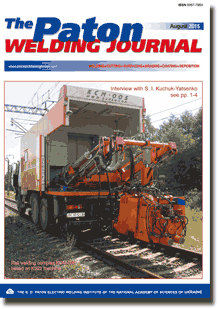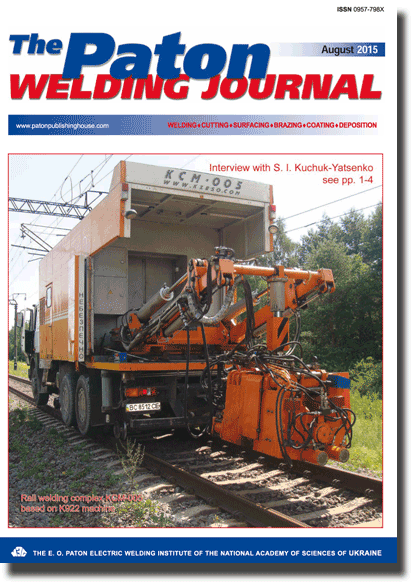| 2015 №08 (06) |
DOI of Article 10.15407/tpwj2015.08.07 |
2015 №08 (08) |

The Paton Welding Journal, 2015, #8, 35-38 pages
Application of pulse welding power sources in electrochemical processes
A.M. Zhernosekov And V.M. Kislitsyn
E.O. Paton Electric Welding Institute, NASU. 11 Bozhenko Str., 03680, Kiev, Ukraine. E-mail: office@paton.kiev.ua
Abstract
It was determined that area of application of pulse welding power sources for processes of metal flame treatment can be expended. At that continuously rising in price natural gas is substituted by hydrogen-oxygen mixtures or hydrogen. Application of nickel instead of low-carbon steel as electrodes at water electrolysis allowed reducing process voltage to 2.1 V. Dependence of increase of percent content of finer powder fractions (1-50 mm and 1 mm, and less) at increase of frequency of current of anode dissolution was determined. Received results indicate perspectives of investigations in this direction for increase of efficiency of electrochemical processes of hydrogen production as well as micro- and nanopowders for manufacture of welding and brazing powder consumables. 12 Ref., 3 Figures.
Keywords: power sources, pulse frequency, generators of hydrogen-oxygen mixtures and hydrogen, micropowders of metals, process efficiency
Received: 12.03.15
Published: 13.10.15
References
- Zhernosekov, A.M., Andreev, V.V. (2007) Pulsed metal arc welding (Review). The Paton Welding J., 10, 40-43.
- Zhernosekov, A.M. (2012) Tendencies in development of control of metal transfer processes in shielding gases (Review). Ibid., 1, 29-33.
- Shejko, P.P., Pavshuk, V.M., Zhernosekov, A.M. et al. (2003) Power sources for pulsed metal-arc welding with automatic stabilizing of welding parameters. Svarshchik, 4, 4.
- Kudryashov, O.N., Novikov, O.M., Alekseev, I.V. et al. (2001) Welding of structures of aircrafts from thick aluminium alloys. Svarochn. Proizvodstvo, 12, 31-33.
- Lebedev, V.K., Rossoshinsky, A.A., Kislitsyn, V.M. et al. Electrolytic tank for producing of oxyhydrogen gases from water and water solutions. USSR author's cert. 507668. Publ. 27.04.76.
- Pismenny, A.S., Kislitsyn, V.M. (1995) Prospects of development of flame treatment of materials by hydrogen-oxygen mixtures. Avtomatich. Svarka, 2, 39-42.
- Shcherba, A.A., Podoltsev, A.D., Kucheryavaya, L.N. et al. (2005) Spark-eroded particles: Size analysis, cooling rate, microstructure. Tekhnich. Elektrodynamika, 5, 3-8.
- (2014) Technology using microwave heating may impact electronics manufacture. http://www.technology.org/2014/06/11/technology-using-microwave- heating-may-impact-electronicsmanufacture/
- Zhernosekov, A.M., Kislitsyn, V.M. (2007) Efficiency enhancement of gas generators of hydrogen-oxygen mixture. The Paton Welding J., 4, 51-52.
- Lebedev, V.V. (1969) Physical-chemical principles of producing of hydrogen from water. Moscow: Nauka.
- Fioshin, M.Ya., Pavlov, V.V. (1976) Electrolysis in inorganic chemistry. Moscow: Nauka.
- Pismenny, A.S., Shvets, V.I., Kuchuk-Yatsenko, V.S. et al. (2008) On issue of brazing metals using powder braze alloys of different dispersity. The Paton Welding J., 12, 34-36.
Suggested Citation
A.M. Zhernosekov And V.M. Kislitsyn (2015) Application of pulse welding power sources in electrochemical processes. The Paton Welding J., 08, 35-38.The cost of subscription/purchase order journals or individual articles
| Journal/Currency | Annual Set | 1 issue printed |
1 issue |
one article |
| TPWJ/USD | 384 $ | 32 $ | 26 $ | 13 $ |
| TPWJ/EUR | 348 € | 29 € | 24 € | 12 € |
| TPWJ/UAH | 7200 UAH | 600 UAH | 600 UAH | 280 UAH |
| AS/UAH | 1800 UAH | 300 UAH | 300 UAH | 150 UAH |
| AS/USD | 192 $ | 32 $ | 26 $ | 13 $ |
| AS/EUR | 180 € | 30 € | 25 € | 12 € |
| SEM/UAH | 1200 UAH | 300 UAH | 300 UAH | 150 UAH |
| SEM/USD | 128 $ | 32 $ | 26 $ | 13 $ |
| SEM/EUR | 120 € | 30 € | 25 € | 12 € |
| TDNK/UAH | 1200 UAH | 300 UAH | 300 UAH | 150 UAH |
| TDNK/USD | 128 $ | 32 $ | 26 $ | 13 $ |
| TDNK/EUR | 120 € | 30 € | 25 € | 15 € |
AS = «Automatic Welding» - 6 issues per year;
TPWJ = «PATON WELDING JOURNAL» - 12 issues per year;
SEM = «Electrometallurgy Today» - 4 issues per year;
TDNK = «Technical Diagnostics and Non-Destructive Testing» - 4 issues per year.


